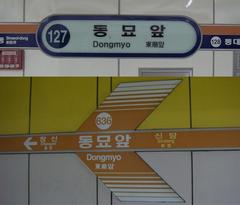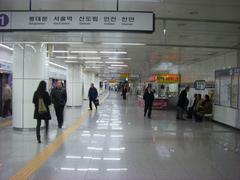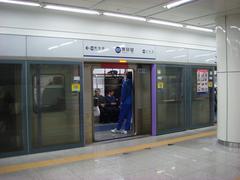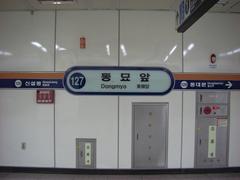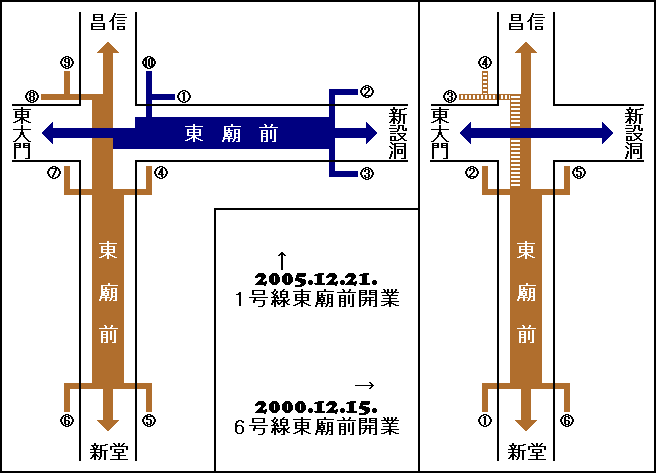
Dongmyo Station Seoul: Visiting Hours, Tickets, and Travel Guide
Date: 14/06/2025
Introduction
Dongmyo Station, located in the heart of Seoul, is much more than a subway stop. It serves as a gateway to the city’s layered history, unique cultural exchanges, and vibrant local life. Named after the nearby Dongmyo Shrine—a rare relic of Korean-Chinese diplomacy from the Joseon era—this area seamlessly blends ancient traditions, bustling urban life, and contemporary attractions. Whether you are passionate about history, a fan of local markets, or simply eager to experience authentic Seoul, this comprehensive guide will help you make the most of your visit.
(Exploring Korea; Wikipedia - Dongmyo)
Table of Contents
- Overview and Historical Background
- Dongmyo Shrine: History, Significance, and Architecture
- Transportation: Getting to Dongmyo Station
- Visiting Dongmyo Shrine: Hours, Tickets, and Tips
- Dongmyo Flea Market and Neighborhood Attractions
- Accessibility, Facilities, and Traveler Safety
- Local Etiquette and Practical Advice
- FAQs
- Conclusion and Recommendations
- References
Overview and Historical Background
Dongmyo Station derives its name and identity from the nearby Dongmyo Shrine (동묘), a vital historical site constructed between 1599 and 1601 during the Joseon Dynasty. The shrine was built at the behest of the Ming Dynasty to honor Guan Yu, a revered Chinese general. This act symbolized gratitude and alliance after the Ming aided Korea during the Imjin War (1592–1598), and the shrine’s Chinese-inspired architecture stands in contrast to Korea’s typical Confucian shrines. Dongmyo Shrine, thus, is an enduring testament to Korean-Chinese diplomatic and cultural exchanges of the early modern era.
(Exploring Korea; Seoul Sub→urban)
Dongmyo Shrine: History, Significance, and Architecture
Historical Context
Dongmyo Shrine was constructed with the support of the Ming Emperor, who provided funds and a calligraphic plaque. As Guan Yu shrines are rare in Korea, its existence was largely the result of diplomatic necessity rather than local religious fervor, reflecting the gratitude (and obligations) of the Joseon court to their Chinese allies.
Cultural and Political Significance
Over the centuries, Dongmyo became an official site for state ceremonies, especially during King Yeongjo’s reign, serving both religious and political purposes. Its continued preservation—especially after concerns arose following the 2008 Namdaemun fire—highlights its national importance. Today, Dongmyo Shrine is designated as Treasure No. 142, recognized for its unique blend of Ming Dynasty and Korean architectural elements.
Architectural Features
Dongmyo Shrine is notable for its Chinese-style design, including a stone and mud wall enclosing over 9,300 m², and a main hall that is deeper than it is wide—contrasting with most Korean shrines. Inside, statues of Guan Yu and his retainers are displayed, including representations of his earthly and spiritual forms.
Transportation: Getting to Dongmyo Station
Dongmyo Station serves both Lines 1 and 6 of the Seoul Metropolitan Subway, making it easily accessible from major points across the city. The station is equipped with clear signage in both Korean and English, and Exits 3 and 6 provide the quickest access to the shrine and flea market.
- Line 1: Connects to major hubs like Seoul Station and Jonggak.
- Line 6: Offers access to neighborhoods such as Itaewon and Eungam.
- Travel Time: From Seoul Station, it takes about 10–12 minutes.
- Fares: Single rides cost ₩1,400–₩1,650 (T-money cards recommended for convenience and discounts).
- Accessibility: Elevators, escalators, and tactile paving are available.
Visiting Dongmyo Shrine: Hours, Tickets, and Tips
- Opening Hours: Daily, 9:00 AM – 6:00 PM (last admission 5:30 PM). Hours may vary on holidays; check ahead.
- Closed Days: Mondays, Lunar New Year, and Chuseok holidays.
- Admission: Free (donations welcome for maintenance and preservation).
- Guided Tours: Offered on weekends and public holidays, or by arrangement through local agencies.
- Visitor Etiquette: Dress modestly, maintain a respectful tone, and check for any photography restrictions.
(The Seoul Guide; Visit Seoul)
Dongmyo Flea Market and Neighborhood Attractions
Dongmyo Flea Market
A major highlight near Dongmyo Station, this sprawling open-air market is beloved for its vintage wares, retro fashion, records, antiques, and quirky curiosities. The market draws a diverse crowd and is open daily except the first and third Tuesdays of each month. Cash is preferred, but some vendors accept mobile payments.
(Korea Herald; Asia News Network)
Nearby Attractions
- Myogaksa Temple: A tranquil Buddhist temple offering Templestay programs.
- Cheonggyecheon Stream: A scenic urban stream ideal for walks.
- Jongmyo Shrine and Changdeokgung Palace: Other major historic sites within a short subway ride.
- SPAREX Jjimjilbang Sauna: Near Exit 6, for a traditional Korean spa experience.
Accessibility, Facilities, and Traveler Safety
- Station Facilities: Clean restrooms, coin lockers (₩2,000–₩4,000 for 4–12 hours), and convenience stores for snacks, drinks, SIM cards, and T-money top-ups.
- ATM Access: Look for “Global ATM” for international cards.
- Safety: Regular police patrols, extensive CCTV, and tourist police support (dial 1330 for English help).
- Accessibility: Ramps, elevators, and accessible paths for wheelchair users; staff assistance available.
(Visit Seoul; Travel Safe Abroad)
Local Etiquette and Practical Advice
- Eating and drinking are prohibited in the subway and at the shrine.
- Bargaining is common at the flea market; translation apps may be helpful.
- Dispose of trash properly—Seoul prioritizes public cleanliness.
- Be mindful of rush hours (7:30–9:00 AM, 6:00–8:00 PM), as the station can get crowded.
FAQs
Q: What are the visiting hours for Dongmyo Shrine?
A: 9:00 AM to 6:00 PM daily (last entry 5:30 PM); closed Mondays and major holidays.
Q: Is there an entrance fee?
A: No, admission is free; donations are appreciated.
Q: Is Dongmyo Shrine wheelchair accessible?
A: Yes, with ramps and accessible paths.
Q: How do I get to Dongmyo Shrine from the station?
A: Use Exit 3 or 6; the shrine is a short walk and signposted.
Q: Are guided tours available?
A: Yes, on weekends, holidays, or via local tour agencies.
Q: Is the flea market open every day?
A: Open daily except the first and third Tuesdays of each month.
Conclusion and Recommendations
Dongmyo Station is a living, dynamic part of Seoul’s urban landscape—combining the cultural legacy of the Ming Dynasty-inspired Dongmyo Shrine with the lively energy of the flea market and nearby attractions. Its free admission, excellent accessibility, and role as a transit hub make it an inviting destination for all travelers. To enhance your experience, check for updated hours and special events, and consider exploring the neighborhood’s diverse food, shopping, and cultural scenes.
For seamless travel, download the Audiala app, follow our social media for real-time updates, and consult official tourism resources before your trip. Dive into Seoul’s past and present, starting at Dongmyo Station.
References
- Exploring Korea – Dongmyo Shrine Seoul
- Seoul Sub→urban – Dongmyo Station Information
- Korea Herald – South Korea’s Dongmyo Flea Market
- Asia News Network – South Korea’s Dongmyo Flea Market
- The Seoul Guide – Dongmyo Shrine
- Wikipedia – Dongmyo
- Namu Wiki – Dongmyo Station
- Visit Seoul – Safety and Tourism Information
- KoreaToDo – Korean Travel Guide
- Travel Safe Abroad – Seoul

